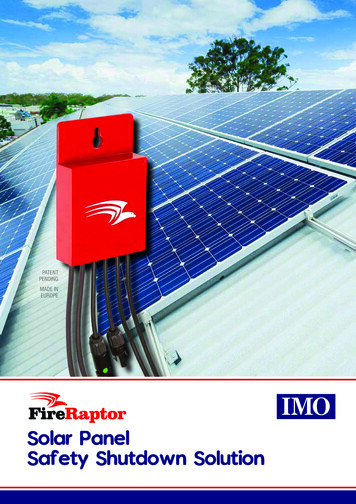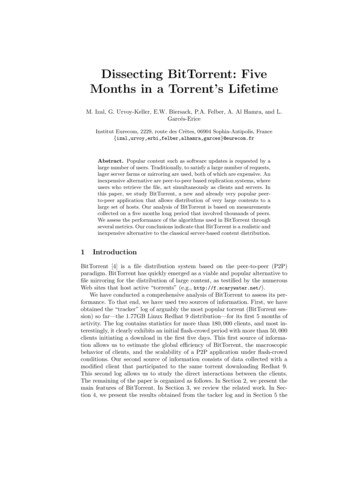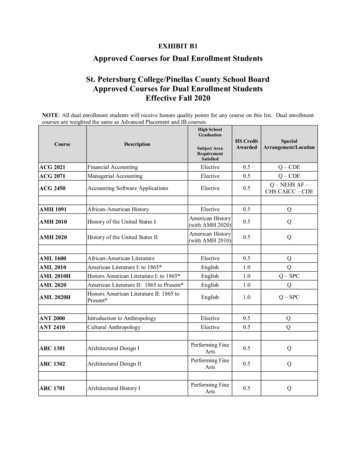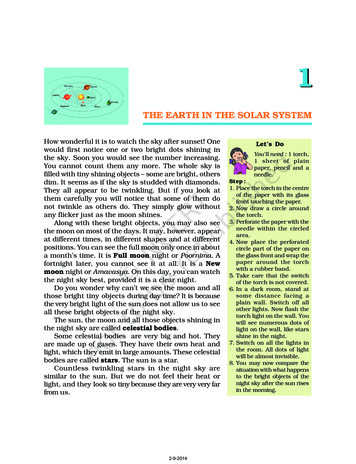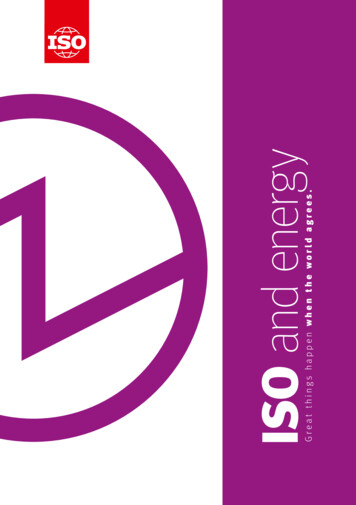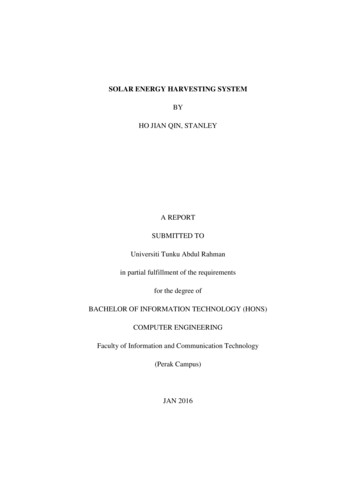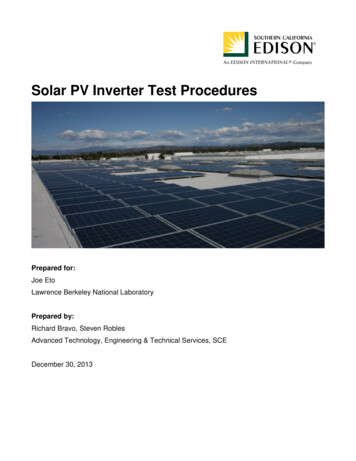Transcription
Dual-Axis Solar Tracker:Functional Model Realizationand Full-Scale SimulationsPicture of the Functional ModelPicture of a SimulationPicture of a SimulationAuthorsKeywordsDante Johnson-HoyteMelanie Li Sing HowMyo ThawDante RossiSolar TrackerDual-Axisi
Dual-Axis Solar Tracker:Functional Model Realization and Full-Scale SimulationsA Major Qualifying Project Reportsubmitted to the Faculty ofWORCESTER POLYTECHNIC INSTITUTEin partial fulfillment of the requirements for theDegree of Bachelor of SciencebyDante Johnson-HoyteMelanie Li Sing HowDante RossiMyo ThawDate:March 10 2013Sponsored byFrench Development EnterprisesSubmitted to:Professor Alexander Emanuel, Advisor, WPIProfessor Stephen S. Nestinger, Advisor, WPIThis report represents the work of four WPI undergraduate students submitted to the faculty as evidenceof completion of a degree requirement. WPI routinely publishes these reports on its website withouteditorial or peer review.ii
ABSTRACTThe use of a highly portable, efficient solar tracker can be very useful to applications of the military,industrial, or residential variety. To produce an efficient solar generation system, a scaled down dual-axissolar tracker was designed, built and tested. At most, the solar tracker was perpendicular to the light sourcewithin 3 degrees.iii
ACKNOWLEDGEMENTSiv
LIST OF FIGURESIntroductionResearch background: part 1Research background: part 2Research background: part 3Research background: part 4Research background: part 5Goal statementDesign specificationsDesign DescriptionElectrical systemSensor ?Melanie, MyoMelanieRossi/JohnsonMyoFigure 1: Stationary PV panel orientation Error! Bookmark not defined.Figure 2: Earth's axis tilt/orbital path affecting Solar angle Error! Bookmark not defined.Figure 3: Horizontal single axis trackerError! Bookmark not defined.v
LIST OF TABLESNo table of figures entries found.vi
TABLE OF CONTENTSAbstract . iiiAcknowledgements . ivTable of Authorship .Error! Bookmark not defined.List of Figures . vList of Tables . viTable of Contents . vii1.INTRODUCTION: . 102.Background . 113.Goal statement . 244.Design Specification – Melanie . 245.Design Description – Melanie/Myo . 255.1. Concepts . 265.2. Iterations: . 275.3. Static force analysis . 365.4. Motion and Dynamic force Analysis . 35.5. Sensors .5.5. Stress, Strain and deflection . 115.6. Manufacturing . 375.7. Assembly . 37Appendix A. 38Appendix B . 39vii
(Detailed) TENTATIVE!!1. Introduction.42. Background Research.52.1.Green Energy Needs.2.2.Essentials of Solar Systems.2.3.Types of Solar Systems.2.4.2.4. Technological Improvements over the years.3. Goal Statement.104. Functional Model104.1.Design Specifications.4.2.Design Description.4.3.Design Iterations & Final Design.4.4.Analysis.4.5.Manufacturing and Assembly.4.6.Results.5. STS 444.5.1.Design modeling (blueprints) .5.2.Static and Dynamic Analysis (?).5.3.Wind Load Analysis.11275.3.1. Simulation data ( mathematical model) .5.3.2. Experimental data: Wind Tunnel Testing.5.3.2.1.Materials.5.3.2.2.Model design (scaling, blockage factor) .5.3.2.3.Methodology & set up (system support, measurement device,calibration, data collection) .viii
5.3.2.4.Mathematical model.5.3.2.5.Results and discussion.5.3.3. Comparison and conclusion ? .5.4.Snow Load Analysis.5.5.Results & Discussion (? Final or after each section 5.2-5.4)? .5.6.Conclusion?.5.7.Recommendation.4. Conclusions (?for the whole project/model/simulation?).285. Bibliography.296. Appendices.307. Computer Disk. inside front coverix
1. INTRODUCTION:Solar power is the fastest growing means of renewable energy production with grid connectedsolar capacity increasing on average by 60 % annually from 2004 to 2009 according to theNational Center for Policy Analysis [A]. Yet solar energy contributes to only The currentsituation of the more mature segment of solar energy production, the Photovoltaic (PV) solar celltechnology, is one in which energy production is improving from .(energy capacity value)!!Stanford University Professor Stefan Reichelstein, author of the new working paper “TheProspects for Cost-Competitive Solar PV Power,” believe the future of PV solar technologieslook promising considering favorable location and continued federal tax subsidies [A] as well asstate renewable standard protocol [B]. According to him, with the continued trend in decreasingcost of PV panels and government subsidies, PV Solar energy might become cost competitive inthe next 10 years (subsidy-free), for commercial installations while for Utility-scale installationsit will take longer [A]. The August 2010 White House report on the other hand predicted that PVsolar power will reach grid parity by 2015. Regardless of the diverging predicted time period forgrid parity equivalence with current price, it is unequivocal that for solar photovoltaic energyproduction to become a reality it has to compete with other available sources of energy.Subsequently, it is believed that Solar tracking will contribute significantly in increasing theefficiency of energy collection from the PV panels. Novel Dual-Axis solar systems allow forprecise control of the elevation and azimuth angle of the panel relative to the sun. Tracking isreported to potentially double the energy output of a fixed PV Solar system. The FrenchDevelopment Enterprises (FDE) are currently developing a patented Dual-Axis Solar system thatin addition to tracking the sun via sensitive sensors (add more attributes), it can be rapidlydeployable and transportable with an automatic? default position in extreme weather conditions.Among the benefits of this remotely articulated solar tracker include a maximum tilting angle of80 degrees with the horizontal axis to remove accumulated snow and sensitivity speed of fromone extreme position to the other. During the three months of tracking the sun with theircommercial Single-Axis solar system, they have been obtaining a positive power efficiencyof (estimate from website they gave us) which (state good or bad estimate for future dualaxis STS).This report will therefore focus on the force and stress analysis of the Dual-Axis Solar system(STS 444) different configuration under the critical wind and snow conditions. The second partof the report will be based on modeling a table-top sized prototype for the FDE to demonstratethe tilting and sensing-responsive abilities of the prototype to potential clients.
2. BACKGROUND2.1.Describe the need for green energy -- why PV instead of other green type of energy collection -- why tracking JOHNSONThere is a great and growing need for renewable energy, in particular green energy. In years to come wewill want a source of energy that will leave future generations with a sustainable energy source. A fewgood reasons to improve our green energy market are because not only do we want to have renewableenergy for future generations, but we also want to have a sustainable energy market in future. Greenenergy has shown sustainable growth in past years, where oil has obviously not. In order to power ourhomes, businesses, and most aspects of our daily lives we require electricity, which requires massivepower plants and spending billions of dollars to run them. But what if we could avoid all the resourcesthat are used generating this energy, and replace them with green energy that could provide powerdirectly to the consumers like businesses, the military or even private homes.The military will most likely be one the major user of renewable energy in the future. The departmentof defense plans on opening up 16 million acres of land for renewable energy development, whichincludes solar energy development. To highlight how new this is, the DOD only made thisannouncement in early August, meaning solar energy is a major market and a technology of greatinterest to our nation. There are also many other major solar energy projects that the military ispartaking in such as The Sterling solar power renewable energy construction project which havesupplied an Army depot outside Salt Lake City with approximately 30% of there power, potentiallypowering up to 400 homes. Another project is the renewable energy project at the U.S. Army GarrisonKaiserslautern in Kaiserslauter, Germany that will generate enough energy to power 500 homes. Infuture there are plans to generate enough power on military installations to power 750,000 homes by2025.Currently in order to run a military base large generators are required, which are reported to be notnearly as efficient as solar panels could be, and consume large amounts of fuel in order to run. Theneeds of future military installments are to have renewable energy sources that require less maintenanceand are more energy efficient as opposed to petroleum. In addition, solar energy will not only be usedfor military bases, but also for mobile military units as well, which will be more efficient at providingsoldiers energy for their equipment used in the field.Overall it is dangerous to depend strictly on fossil fuels. It is dangerous politically, economically, andnaturally. Politically we want the country to not have to depend on petroleum from other countries.Being dependent on other countries, especially as the top consumer of fossil fuels, would have anegative impact on our country in the future; that is when they resources disappeared. On the economicside, our country would be in better shape to be more self sustaining in future. On the environmentalside, when it comes to burning these fossil fuels, although debated on how bad the environmental effectis, it is known to produce large amounts of carbon dioxide.Some have complained about the true benefits of solar power, and argue that it is not cost effectiveenough to be worthwhile. On the other hand reports have shown that costs have gone down forsomething like installments at home, and that the payoff for installing them would be even greater. Thecost per watt has been estimated at 4.85/Watt, which is said to be a 50% increase since 5 years earlier.Although the cost for at home installation is said to cost around 5,000, the life of solar panels is said tobe incredibly long, and only lose around half a percent of their maximum power each year. This makesthem a great technology to invest in and continue to develop, so that in future they can produce evenmore power. This way, states like California can reach their goal of 33% solar energy dependency by
2025. Like this many countries have started to make this move toward green energy and energyindependence; this is because they know it is the energy of the future.2.2.what are the essentials of a solar panel in general and that of a solar tracker, list of componentand function etc JENNIFER2.3.Type of solar trackers (History/patents/publication) ROSSIThe effectiveness of a solar tracker and PV technology in general, is directly correlated to theamount of sunlight that it is being exposed to; its power output is dependent on the amount of light thatreaches the solar cell. PV technology is most efficient when it is greeted by a light source at a perfectlyperpendicular angle, i.e. forming a 90 degree angle. In order to accomplish this in a real-world situation,the PV panel must move with the sun to maintain this perpendicular angle. [6] Mehleri, E.D., P.L. Zervas, H.Sarimveis, J.A. Palyvos, and N.C. Markatos. "Determination of the Optimal Tilt Angle and Orientation for Solar Photovoltaic Arrays."Renewable Energy 35.11 (2010): 2468-475.This is where the necessity for solar tracking comes in. Solar tracking is not a new concept,though it is a considerably new concept compared to PV cells. Patents began to be filed in regards tosolar tracking, and even before that regarding simple light sensing technology, soon after thecommercial availability of efficient PV panels hit the market: about 50 years tsec abstract#v onepage&q&f false ] Like most technology today,a large collection of solar tracking systems exist, ranging in price, effectiveness, reliability, etc. Thedesign options for a solar tracking system must be taken into careful consideration to ensure that thesystem is maximizing its output from tracking the sun. If key aspects of the application needs were to beneglected, the solar tracker could actual under-perform a well-positioned stationary PV panel.Even though solar tracking will inherently give a greater power output than a stationary PVpanel, the option is not always ideal. Due to the increased cost for solar tracking technology versusstationary PV panels, solar tracking is not always the best option for a given application. If a stationaryPV panel is utilized, it is strategically placed facing the sun. The considerations to be taken regardingPV panel placement is that the panel must be placed in a spot where it will always have a clear line ofsight (LOS) to the sun, and the panel must be positioned at an optimal angle facing the equator,depending on its latitude on earth, see figure 1. [5] Stationary PV panels are a cheaper energy solution,but do not fully utilize the energy coming from the sun.Figure 1: Stationary PV panel orientation
Due to the fact that the earth is rotating on a tilted axis and takes an elliptical path around thesun, a stationary PV panel’s output will drastically vary throughout the year and even throughout thecourse of a day, see figure 2.Figure 2: Earth's axis tilt/orbital path affecting Solar angleSolar tracking obviously addresses these issues by actively following the sun in the sky. A standard PVpanel will observe about 20-35% efficiency under ideal conditions, while solar tracking has been knownto potentially double that with 50-60% efficiency under ideal conditions. [8] H. Mousazadeh et al., Areview of principle and suntracking methods for maximizing solar systems output, Renewable andSustainable Energy Reviews 13 (2009) 1800–1818. In general there are two main groups that cancategorize solar trackers: single or dual axis trackers. Single axis trackers singularly follow the Sun’sEast-West (or even North-South) movement, while the two-axis trackers follow the Sun’s exactmovement, no mater what direction. Typically tracking is done, considering a single axis at a time, byusing two photoresistors or PV cells used as sensors. These sensors are strategically placed next to oneanother and have a divider/tilted mount of some sort to create a voltage difference. This voltagedifference is then used to determine which way the panel needs to turn to face the sun perpendicularly.The first type of active solar collecting is single axis tracking. This is will result in a greaterpower output than stationary PV panels, but is also more costly to design and implement. Single axissolar trackers can either have a horizontal or a vertical axis. The horizontal type is used in regions nearthe equator where the sun gets very high at noon, thus not having to adjust to vertical changes so muchas horizontal changes, see figure 3.Figure 3: Horizontal single axis tracker
[7] The vertical type is used in high latitudes where the sun does not get very high, but summerdays can be very long. Conversely, utilizing the fact that vertical movement does not have to becompensated for as much as horizontal movement, see figure 4.[7]Figure 4: Vertical Single axis trackerThe second type of active solar collecting is dual axis tracking. This results in a much greater poweroutput than a stationary PV panel, but is also the most costly and most complicated to design. Dual axissolar trackers have both a horizontal and a vertical axis and thus they can track the sun's apparent motionvirtually anywhere in the sky no matter where it is positioned on earth, see figure 5. [5] P. Roth et al., Cheaptwo axis sun following device, Energy Conversion and Management 46 (2005) 1179–1192]Figure 5: Standard Dual axis trackerMany traditional solar PV applications employ dual axis trackers to position the solar panelsperpendicular to the sun’s rays. This maximizes the total power output by keeping the panels in directsunlight for the maximum number of hours per day. [7][1] http://www.google.com/patents/US4031385?printsec abstract#v onepage&q&f falseInventors: GeneA.Zerlaut,OriginalAssignee: DesertSunshineCurrentU.S.Classification: 250/203.4;126/575;International Classification: G01J nc.356/139.01[2] http://www.google.com/patents/US4225781?printsec abstract#v onepage&q&f falseInventor: BurrellE.HammonsOriginal Assignee: The United States of America as represented by the United States Department of Energy
PrimaryExaminer: DanielCurrent U.S. Classification: 250/203.4; 126/573; 250/237.00R; 356/139.01[3] http://www.google.com/patents?id FkuAAAAEBAJ&printsec abstract&zoom 4#v onepage&q&f falseInventor: KeiPrimaryExaminer: ErnestAustin,Current U.S. Classification: 250/208.2; 126/573; 356/121O'ConnorMoriII[4] s/literature/documents/wp/oem-wp009 -en-p.pdfSolar Tracking Application (A Rockwell Automation White Paper)[5]P. Roth et al., Cheap two axis sun following device, EnergyConversion and Management 46 (2005) 1179–1192[6]Mehleri, E.D., P.L. Zervas, H. Sarimveis, J.A. Palyvos, and N.C. Markatos. "Determination of the Optimal Tilt Angle andOrientation for Solar Photovoltaic Arrays." Renewable Energy 35.11 (2010): 2468-475.[7]Reda, Ibrahim, and Afshin Andreas. Solar Position Algorithm for Solar Radiation Applications. Tech. N.p.: National RenewableEnergy Laboratory, n.d.H. Mousazadeh et al., A review of principle and suntracking methods for maximizing solarsystems output, Renewable and Sustainable Energy Reviews 13 (2009) 1800–1818.[8]2.4.Specific improvement in mechanical design and ECE design over past generation solar trackers(from single to dual axis etc) MYOTracking systemActive trackingActive tracking uses motors, gears, and actuators to position the solar tracker so that it is perpendicularto the sunlight. Trackers that use sensors to track the sun position inputs data into the controller, whichin turns drives the motors and actuators to position the tracker. There are also trackers that uses solarmap. Depending on the location, solar maps give information on where the sun is at different time ofday throughout the year. Trackers that use solar map do not need sensors input to track the sun. Butthere are also tracker that uses both sensors and solar map. During sunny weather, the sensor would beused to track the sun. But during cloud-covered times, the information from the solar map would beused. It is important to track the sun even in cloudy condition since solar panels can produce energyduring cloudy conditions.PassivePassive trackers use compressed gas to move the tracker. Depending on the position sunlight is fallingon the gas containers difference in gas pressure is created, moving the tracker until it gets to anequilibrium position. The advantage of passive tracker is that the tracking system does not require acontroller. But passive trackers are slow in response and are vulnerable to wind gusts.
SensorsAny device that is sensitive to the intensity of light can be used as solar tracking sensors. Two of thosesimilar devices can be placed at an angle as shown in the figure below.When the sun is on the left, the sensor on the left receives more light than the one on the left. If thesensors produce voltage with light intensity, the left sensor would produce more voltage than the one onthe left. From the result, we can know that the sun is on the left. When the two sensors are outputtingthe same value, we know that the sun must be at the top, perpendicular to the sensor unit.Photovoltaic cellsPhotovoltaic cells, those when combined made up a solar panel, can be used to detect light intensity. Itproduces the maximum voltage when the sun is perpendicular to the cells. As the angle between the celland the sunray decreases, the voltage also drops. When the cells are parallel with the sunlight, it willproduce a minimum voltage.Light Dependent Resistor (LDR)
Light dependent resistors or photoresistor is a type of resistor who resistance depends on the amount oflight falling on the sensor. The resistor of LDR increases with decreasing light intensity.Different sizes of LDR being soldLight Emitting Diode (LED)Light emitting diode is a type of diode that products light when current flows through its terminal. But italso has a property of producing current when it receives light, just like a photodiode. As the lightintensity increases, the current an LED produces also increases.PhotodiodeControllersThe main purpose of the controller is to receive data from the sensors, process it, and give signals todrive the motors and actuators. Looking at it simply, a human can take the place of a controller. Aperson can see where the sun is and rotate the tracker manually to get the most energy. But it is not afeasible option for a long term or when there is more than one tracker, like in a solar power plant. Soautomated controllers become a necessity. Controllers must also take into account what to do when thesun sets, when the wind is too high, or other physical conditions.Programmable Logic Controller (PLC)PLC are like a mini computer, but its main purpose is to control processes that are repetitive. It hasinput terminal for analog and digital input, a processor to do arithmetic, and output terminal to control
machineries. It is mostly used in assembly lines. Since solar tracking is also a repetitive activity, a PLCcan be programmed to take in data from the sensors, process the information, and output signals to themotors and actuators. Since PLC is an old technology, the devices are often bulky and also expensive.ML 1500 PLC from Allen-BradleyMicrocontrollersMicrocontrollers can perform very similar tasks as PLCs, but the size of the device is much smaller. Aprocessor, memory, and the input/output peripherals are all embedded into a single integrated circuit(IC) about the size of a fingernail. They are very cheap, costing around 3 for a single IC. But thedisadvantage of microcontrollers is that they are made to control small appliances. Communicationterminals such as LAN are not common in microcontroller boards, unlike the PLCs. So usingmicrocontrollers for solar tracking in a power plant is not very feasible in terms of status monitoring andcontrolling them for maintenance. But it would be the best option for a home use tracker or for aprototype.Atmel ATmega328 microcontroller (used in Arduino UNO boards)Analog ICEverything that a microcontroller can do can also be done by analog integrated circuits. There areanalog ICs that are made just for the purpose of solar tracking. But when more features are wanted inthe system, like tilting the solar panels to dispose the snow automatically, analog circuit design becomeinefficient, resulting in several ICs and devices on the controller board.MechanicsSlewing drive
The slewing drive makes sure of the worm drive mechanism to produce torque for rotating. It can befound in many types of machinery such as wind turbines, cranes, and telescopes. But they are alsowidely used in solar trackers to provide rotational movement, mainly in vertical direction. These areknown as single axis slewing drive. Because slewing drive uses a worn drive system, it is self-lockingor irreversible. This makes the slewing drive resistant to wind and other external forces on the trackers.A slewing drive is made by combining the gearing, bearings, seals, housing and other components intoone single unit.A single axis slewing drive made by Kinematics Manufacturing, Inc73 kg slewing drives begin assembled at Beijing Titanhorse Industry and TradingAs demand for solar tracking increases, dual slewing drives are now in mass production. Two slewingdrives and two motors are combined into one unit, which can be mounted on top of a tower. With thedual axis slewing drive, a single unit can provide both the horizontal and vertical rotations.
Custom designed dual axis tracking drive made by /solar appimg1.jpg]Most of the dual slewing drive in production are intended for use in solar power plants, but smaller dualslewing drives are also available for home use, as the one shown below.A dual axis slewing drive made by Kinematics Manufacturing, Inc[http://en.wikipedia.org/wiki/File:Kinematics Slewing Drive.jpg]There are also slewing drives that make use spur gear instead of the worm gear to achieve rotationalmotion. A motor connected to a small spur gear is mounted vertically, and as the motor rotates, the spurgear rotates itself against the teeth of a stationary ring gear. Both the internal and external ring gear canbe used for this design. Because this type is not self-locking, the motor must have other lockingmechanism to withstand external forces.
Spur gear driven slewing drive manufactured by IMO[http://www.goimo.com/Series SP-I.1492.0.html]Linear ActuatorA linear actuator creates motion in a straight line. There are many types of linear actuators available:mechanical, hydraulic, pneumatic, etc. The most common is the mechanical linear actuator. Many ofthem use a screw and an electric motor to rotate the screw to produce a linear motion. Linear actuatorsthat use acme screw are self-locking, compare to ball screw that is not. Some linear actuators have avariable resistor inside that changes in value depending on the location of the stroke. That resistor canbe used to get feedback data on the location of the stroke.A linear actuator made by g.php]Linear actuators are widely used in home solar tracking application since it is easy to control andrelatively inexpensive. Horizontal rotation can be achieved by mounting the base of the linear actuatoron a tracker frame and the stroke connected to the solar panels. Linear actuators with varying strokelength and gear ratio (which determines the maximum thrust) can be purchased.In many cases, both the linear actuator and the slewing drive are used to achieve dual axis tracking.
A complete dual axis tracing system made by Sunflower ng-Drive.html]2.5.Future potential of solar trackers -- any use
Mar 10, 2013 · The use of a highly portable, efficient solar tracker can be very useful to applications of the military, industrial, or residential variety. To produce an efficient solar generation system, a scaled down dual-axis solar tracker was designed, built and tested. At most, the solar tracke
